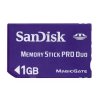tom_electronic
Member
Memory Stick is a removable flash memory card format, launched by Sony in October 1998, and is also used in general to describe the whole family of Memory Sticks. In addition to the original Memory Stick, this family includes the Memory Stick PRO, a revision that allows greater maximum storage capacity and faster file transfer speeds; Memory Stick Duo, a small-form-factor version of the Memory Stick (including the PRO Duo); and the even smaller Memory Stick Micro (M2). In December 2006 Sony added the Memory Stick PRO-HG, a high speed variant of the PRO to be used in high definition still and video cameras.






